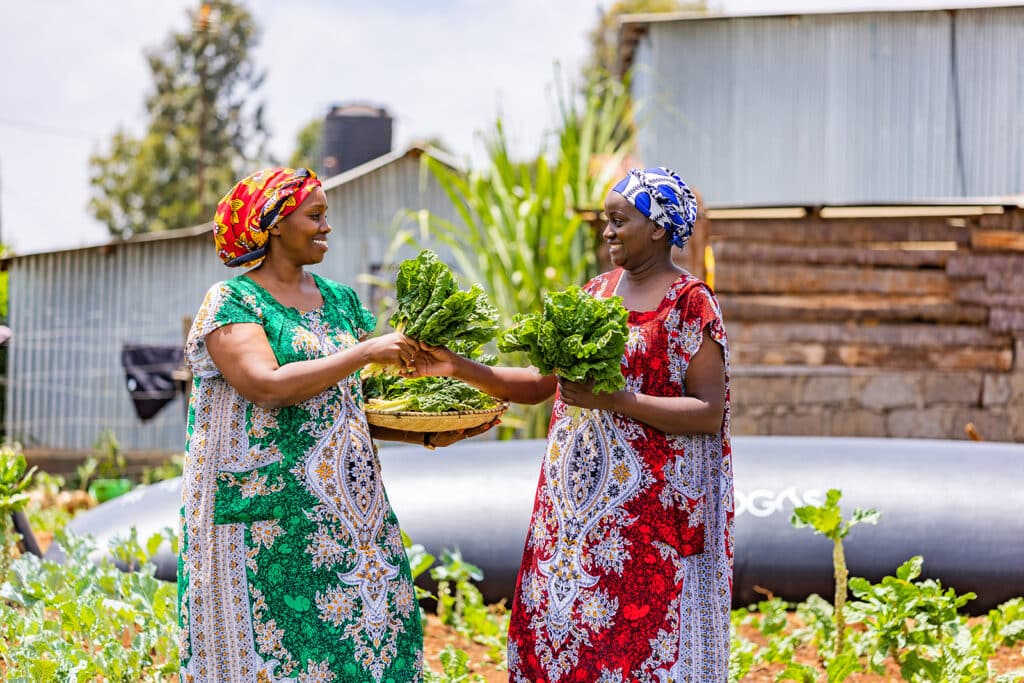
What is Renewable Natural Gas, and How is it Made?
Renewable natural gas (RNG) is methane derived from decomposing feedstocks, being also known as biogas. Biogas and natural gas have the same chemical composition, but the former doesn’t require drilling, making it a sustainable energy source.
When bacteria break down animal waste and rubbish, they produce methane-containing gases, which are further collected, cleaned up, and fed into a pipeline. Methane gas obtained this way can produce heat or electricity. If this organic matter isn’t processed to obtain biogas, the waste still decomposes, and the gas from manure ponds goes into the atmosphere, becoming a greenhouse gas.
Another variety of RNG is produced synthetically through chemical interactions between water and carbon dioxide molecules or by thermal gasification of biomass—such as crop wastes or logging debris.
What is the Difference Between Renewable Natural Gas and Natural Gas?
Renewable natural gas and natural gas have the same chemical composition and, therefore, the same applications. The distinction between these two products consists of how each gas is produced and impacts the environment.
Natural gas is a fossil fuel created when dead plants and animals are subjected to high heat and pressure. It is not a renewable energy source or carbon-neutral, as it contributes to climate change because it releases more CO2 into the atmosphere than it removes.
Natural gas is labeled as the cleanest fossil fuel. Still, it’s far more dangerous for the environment than renewable natural gas because all stages of the natural gas production process harm the environment.
Renewable natural gas is carbon-neutral, absorbing as much CO2 as it releases into the atmosphere. When capturing and burning methane, biogas plants and digesters counter climate change. The RNG production process traps greenhouse gases that would otherwise be released into the atmosphere and contaminate the areas around landfills.
RNG is considered a renewable resource, as it originates from sources that can be replaced or refilled in less time.
What are the Main Sources of Renewable Natural Gas?
- Waste from residential, industrial, and commercial enterprises. In this case, the product is landfill gas produced by anaerobic bacteria in municipal solid waste landfills. The process occurs outside a digester, so landfill gas can be hazardous to both people and the environment, so a landfill gas collection and control system is required.
- Animal manure and other livestock operations. Farms (especially dairy farms) use anaerobic digesters to create biogas from waste and old bedding materials from their barns. Some livestock producers cover their manure lagoons, also known as manure holding ponds, to collect the biogas developed there. Methane from the biogas can be burned to heat buildings and water, as well as to power diesel generators on the farm. In 2020 alone, 20 sizable dairy and livestock businesses in the US generated a combined 173 million kWh (or 0.17 billion kWh) of power from biogas.
- Wastewater treatment. Anaerobic digesters are common in municipal sewage treatment facilities, and the biogas resulting from the decomposition process heats the digesters, enhancing the anaerobic digestion process and eliminating pathogens. In other cases, the biogas generates electricity for the facility’s use or sale.
How is Renewable Natural Gas Used?
Renewable natural gas has as many applications as natural gas. Currently, it’s a popular transportation fuel alternative, particularly for diesel in heavy-duty vehicles. As more governments give renewable natural gas production credit for its environmental benefits, the interest in biogas’s potential as a gas green energy source has increased significantly.
Using renewable natural gas can significantly decrease methane emissions by replacing fossil fuels across multiple sectors and industries. This is especially true in high-density, combustion-based industries like heavy-duty transportation and industrial heating. Moreover, using renewable natural gas in the existing gas infrastructure makes it a cost-effective option for decarbonization in the near future.
Currently, the most typical applications for renewable natural gas are:
- Cooking gas, mainly in rural and off-grid areas
- Generating power by burning and developing steam
- Heating domestic and industrial properties
- Replacing compressed natural gas for automobiles
- Substituting carbon dioxide in on-site CHP facilities
- Public transportation
- Hydrogen fuel cells
Biogas has become one of the fastest-growing types of bioenergy in both the Stated Policies Scenario (STEPS) and the Sustainable Development Scenario (SDS) for the future of gas green energy. Biogas and biomethane can reach a market share in the overall modern energy demand of up to 20% by 2040, so we can expect renewable natural gas to be used across more industries.

Green Energy: How Does Renewable Natural Gas Affect the Climate?
Biogas can be crucial in reducing emissions and mitigating many effects of climate change — at least as a short-term solution. Its contribution is reflected in three major areas:
- It provides an opportunity to prevent organic waste from ending in landfills.
- It generates renewable energy that is already compatible with many existing infrastructure elements.
- It replenishes soil nutrients and organic matter through the fertilizer generated during the decomposition process.
Recycling organic waste
Biogas production reduces methane emissions from landfills and manure lagoons, with substantial advantages for the environment, the general public’s health, and the economy. Turning this methane into CO2 significantly lessens the waste’s impact on the climate, as carbon dioxide has a global warming potential of up to 34 times less than methane.
Municipal solid waste landfills alone rank as the third-largest source of man-generated methane emissions in the US (14.5% in 2020) — equivalent to the GHG emissions from 20.3 million passenger vehicles driven for a year. Agriculture is responsible for another 25% of methane emissions, a large portion of which comes from cattle farming, another renewable source of organic waste for biogas production.
The decomposition process of organic waste ending in landfills starts in an aerobic (with oxygen) environment, so it produces small amounts of methane at first. In little less than a year, anaerobic conditions are developed, and methane-producing bacteria start to break down the waste and produce methane. These emissions often represent a missed chance to harvest and utilize a sizable energy source.
An estimation by the Environmental and Energy Study Institute shows that all of the possible biogas in the United States could reduce methane emissions by 800,000 to 11 million passenger vehicle-worth of emissions annually. Furthermore, compressed natural gas made from biogas reduces greenhouse gas emissions compared to petroleum fuel by up to 91%.
Last but not least, anaerobic digestion reduces infections, odors, and the possibility of livestock waste polluting water sources.
Generating gas green energy
Renewable natural gas is unquestionably a more environmentally friendly choice when compared to natural gas extracted by drilling into the soil. The fracking process necessary to fracture rock formations implies using water, chemicals, and sand, significantly impacting landscapes and ecosystems.
Biogas plants and digesters create a comparable fuel without harming the environment like fracking does by using material that already exists and would otherwise go to the trash.
Animal waste, crop residues, and food waste are the most renewable and sustainable biomass sources that fuel RNG production. These are collected and treated in biogas plants and small digesters where bacteria break down the organic matter and turn it into biogas.
The process continues with purifying and conditioning biogas to minimize or eliminate non-methane components. This treatment enables renewable natural gas to be interchanged with conventional pipeline-quality natural gas so that the existing pipeline infrastructure can distribute it. It’s a cost-effective way to cut back on the use of traditional fuel without requiring massive investment in new infrastructure and equipment.
Being accessible whenever consumers need it makes it a valuable renewable energy source.
Nurturing the soil
The biogas production process is straightforward: you feed the organic waste into the digester, and bacteria begin to break down the organic components, producing liquid biogas and digestate.
The digestate can become compost and fertilizer, which can be used to produce superior crops without harmful chemicals. This way, macronutrients (nitrogen, phosphorus, and potassium), micronutrients (iron, carbon, calcium, magnesium, and sulfur), and organic acids (Humic acid, Amino acids, and more) recirculate and support sustainable plant growth.
It’s a 100% natural product that nurtures plants and enhances the physical attributes of the soil, improving precipitation infiltration and its capacity to store nutrients. This compound reduces the need for synthetic fertilizer, with a long-term impact on soil and water quality.

Main Concerns About Renewable Natural Gas
Correct processing can make biogas a popular alternative to natural gas for electricity generation, public transportation, and commercial and residential heating. However, the biogas solution is not a one-size-fits-all method to cut emissions and doesn’t come without risks.
Concerns about renewable natural gas are mostly related to maintaining a balance with waste management and not slowing down the development of other zero-carbon energy sources.
Here are some that make renewable natural gas challenging to use at scale:
- The world’s capacity to produce biogas is insufficient, so this energy source can’t replace all the natural gas we use. Therefore, there might be a risk of generating more waste to create biogas, which would end up harming the environment. Biogas should primarily be used in industries that require extreme heat, which only gas can deliver. Other sectors should focus on other sources of clean power.
- Biogas production and adoption require upfront installation costs. Small biogas plants near cattle farms and domestic biogas systems don’t come cheap, and the initial investment pays off in time. Large biogas plants, too, imply a series of investments in infrastructure and equipment to become productive and supply consistent amounts of energy month over month.
- Biogas shouldn’t slow down the development of other natural gas alternatives. Expanding the existing gas infrastructure further will make it difficult to reach global decarbonization goals. It’s essential to electrify a series of processes using zero-carbon energy sources like wind and solar to produce electricity to balance and optimize energy production.
- The natural gas vs biogas debate also focuses on how companies in the gas sector have been using renewable natural gas to improve their public image. These producers generate positive publicity around a product they struggle to supply while mixing biogas with natural gas and selling it as a “renewable” solution. This strategy generates the illusion they can decarbonize industries with a significant long-term impact on the environment.
Renewable Natural Gas in Rural Communities
While biogas production at scale could generate serious debate, small domestic production can fix a series of issues with minimum environmental impact. Biogas technology offers valuable fuel and an improved lifestyle in rural and off-grid areas where sewage systems are rare, and communities grow domestic animals.
Utilizing biogas has environmental benefits, preventing climate change and preserving forests. Residential biogas systems can keep animal waste from landfills, cut annual firewood use, and reduce water and air pollution. At the same time, they save lives and reduce a significant part of the 2% of greenhouse gas emissions worldwide caused by cooking with non-renewable wood fuels.
What are the Challenges of Developing RNG Production?
The following factors hamper the production of renewable natural gas:
- Upfront project costs. Depending on their size, biogas plants can cost millions to install machinery and tie pipelines.
- Feedstock inconsistency throughout the year. Animal manure is available all year round, but its chemical composition and consistency are hard to predict month over month. Moreover, crop residues and other agricultural by-products necessary to maintain a balanced environment inside the digesters are only available during the harvesting season, in quantities that will differ from year to year depending on a series of external factors that can lead to scarcity.
- Regulations, operations, and regional markets. Numerous policies rely on routine financial increases made possible by government appropriations bills. Therefore, uncertainty in the regulatory environment discourages new initiatives since it may modify funding levels or requirements for projects that qualify.
- Market risks of shifting credit and commodity prices dropping. All these results in unpredictable revenue from sales of renewable natural gas. While regulations, bills, and government incentives aim to control risk in this industry, the market continues to be unstable, keeping investors precautious and slowing down the development of new technologies.
Final Thoughts
RNG is an excellent alternative energy source to fossil fuels, including natural gas. However, it can’t replace electricity from alternative sources like wind, solar, or hydro energy. As long as it remains a complementary resource that also addresses waste management issues, biogas will continue to support decarbonization.
When two fundamental conditions are met, renewable natural gas generates significant reductions in greenhouse gas emissions:
- Biogas must be produced using actual garbage without encouraging the production of crops for RNG production.
- The production process must lower methane emissions, meaning that all operations necessary for producing and transporting biogas should have a minimum environmental impact.
While scaling biogas production can be challenging and not the wisest solution to climate change, domestic production can be a cost-effective way to manage waste and provide sustainable energy for small communities.





